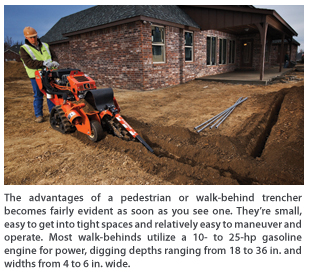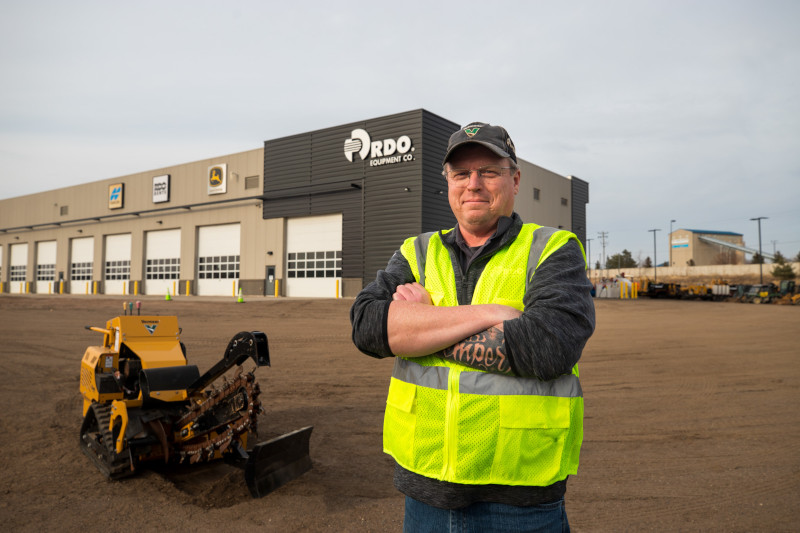Smart Cuts

They’re the old standbys; the go-to machines when the job calls for quick installation of utility conduit, communications cable and drainage, irrigation and sprinkler systems. Compact trenchers, specifically walk-behinds (a.k.a. walk-alongs or pedestrian trenchers), are also used to dig footings for building foundations, curbs and landscape edging and to cut tree and shrub roots and place root control systems in the ground.
 You love them for a lot of reasons — they’re easy to use and easy to transport, get in and around tight jobsites — and rental companies love them just as much, if not more. Through economic ups and downs, changes in markets and technological advances, compact trenchers have remained an important profit center for the rental industry for half a century. The most popular trenchers are walk-behinds, a classification that generally means an engine in the 10- to 20-hp range and trenching capability of up to 6 in. wide and 36 in. deep. Walk-behinds are carried by general rental centers and equipment rental specialists, and some equipment retailers offer trenchers for rent.
You love them for a lot of reasons — they’re easy to use and easy to transport, get in and around tight jobsites — and rental companies love them just as much, if not more. Through economic ups and downs, changes in markets and technological advances, compact trenchers have remained an important profit center for the rental industry for half a century. The most popular trenchers are walk-behinds, a classification that generally means an engine in the 10- to 20-hp range and trenching capability of up to 6 in. wide and 36 in. deep. Walk-behinds are carried by general rental centers and equipment rental specialists, and some equipment retailers offer trenchers for rent.
According to the American Rental Association (ARA), rental of construction and industrial equipment accounted for $24.5 billion — or 69.4 percent — of the $38.3 billion U.S. rental market in 2008. Like most U.S. markets last year, the rental industry saw revenues fall, but by a relatively mild 2.7 percent.*
But not every type of construction equipment experienced a decrease in demand. Charles Hewett of ABC Equipment Rental in Tulsa, Okla., says he has yet to see any drop-off in his company’s walk-behind trencher rentals and doesn’t expect to. He says there are many reasons why walk-behinds remain a popular rental machine in any economy.
“Contractors are reluctant to buy something in a slower economy so they may opt to rent,” says Hewett, whose family-owned company has been renting walk-behinds for 30 of its 57 years in business. “Even when the economy is doing well, we see steady business [in walk-behinds], because a good economy means there is more work to be done, and renting equipment is a fast and easy way to keep up with the demand.”
Walk-behind demand is consistently strong because this equipment is used by so many different types of customers, including plumbers, electricians, landscapers, independent utility contractors and home-builders. And when they walk into a rental center looking for a walk-behind, every contractor should expect certain things from a quality establishment.
A Reliable, Well-Maintained Machine
With so many different types of customers and potential applications, it’s practical for rental companies to stock the most durable and easy-to-maintain machines available. ABC Equipment Rental offers Barreto and Ditch Witch walk-behinds because they are reliable, low-maintenance, easy to operate and are well-known brands.
“Another quality we look for is dealer support,” adds Hewett. “This is a big reason why we like Ditch Witch, for example. Anytime I need a part for a repair, usually we can get the part the same day as the breakdown and have a machine working again within 24 hours.”
Once returned to the store, the machines are cleaned, inspected and repaired, if necessary, to be ready for the next customer. Among the maintenance routines ABC Equipment Rental performs after a trencher is returned are removing dirt and debris by pressure-washing, topping off the fuel, checking all fluid levels, greasing the bearings, cleaning the air filter and checking for worn-out trenching teeth and replacing as necessary. Routine maintenance helps maximize the value of the trencher, so most experienced rental companies are religious about keeping their equipment in excellent working condition. They also understand that customers tend to take better care of a trencher that is clean and well-maintained.
A Fair Price and a Few Obligations
Customers can expect to pay about $150 to rent a walk-behind for a day, $550 for a week and $1,300 for a month. Hewett says most of his customers rent for 24 hours or less. If you rent for longer periods, you will likely be asked to perform some minor maintenance such as checking the oil and grease bearings. Do those simple tasks and that will help you avoid downtime and ensure that you return the equipment in good working order. Like most rented construction equipment, walk-behinds typically have a time limit on daily operation, a restriction designed to limit wear and tear on the machine.
 “Our trenchers have a limit of eight hours of running time for every 24 hours the trencher is kept,” says Hewett. “If they go over the eight hours allowed on the hour meter, there will be an additional charge.”
“Our trenchers have a limit of eight hours of running time for every 24 hours the trencher is kept,” says Hewett. “If they go over the eight hours allowed on the hour meter, there will be an additional charge.”
Hewett says he and his staff are very familiar with the capabilities and operation of each walk-behind trencher in ABC’s inventory. “We have to be in order to provide good service to customers,” he says.
This good service includes training. Most experienced contractors need little training, if any, to operate a walk-behind. Many walk-behind trenchers are designed with the occasional user in mind, so they’re equipped with simple, intuitive controls. “Electricians and plumbers, for the most part, can get by with brief training,” says Hewett. “Do-it-yourself customers need much more instruction, and we’re more than happy to give them all of the training they need until they feel comfortable.”
Good service also includes good advice, which every rental customer should seek if he is the least bit hesitant about operating the walk-behind. “We advise our renters about all the things they should expect with operating the equipment,” says Hewett. “We also make a habit of telling customers about new products that might make their jobs easier. A lot of the time they do not even realize there are new types of equipment. If we know what they’re installing and what kind of jobsite they’re on, we might tell them a vibratory plow or a larger trencher would be a better choice for their application.”
Hewett adds that there’s one piece of advice they give to every customer: Before that digging chain touches the ground, call the national 811 number and/or local Call-Before-You-Dig hotline.
Trencher Options and Insurance
ABC Equipment Rental offers walk-behinds that are capable of trenching between 4 and 6 in. wide, and 30 to 36 in. deep. Models range from 13- to 20-hp. Like most experienced equipment rental stores, ABC understands the various types of soils in the region surrounding it and has an inventory of trencher teeth and chains that are best for the digging conditions.
Insurance is another aspect of your walk-behind rental experience. ABC offers a 10-percent liability policy as an option, meaning that you can pay 10 percent of the rental price and be protected against minor damage such as broken trencher teeth or replacing a chain that slips off the boom. Other equipment rental companies automatically figure insurance into your rental price.
A selection of quality brands, dependable service and great customer support at a fair price. The things you expect from any retail establishment are the same things you should expect when you rent a walk-behind trencher.
Jeri Lamerton the public relations and advertising manager for Ditch Witch, based in Perry, Okla.
*Source: American Rental Association Report: 2008 State of the Equipment Rental Industry.




Comments are closed here.